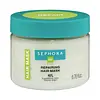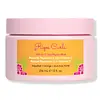What's inside
What's inside
 Key Ingredients
Key Ingredients

 Benefits
Benefits

 Concerns
Concerns

 Ingredients Side-by-side
Ingredients Side-by-side

Water
Skin ConditioningCetearyl Alcohol
EmollientStearyl Alcohol
EmollientButyrospermum Parkii Butter
Skin ConditioningOrbignya Oleifera Seed Oil
EmollientGlycerin
HumectantIsoamyl Laurate
EmollientHydroxypropyl Starch Phosphate
Behentrimonium Chloride
PreservativeErythritol
HumectantAdansonia Digitata Seed Oil
EmollientPlukenetia Volubilis Seed Oil
EmollientHydroxyacetophenone
AntioxidantParfum
MaskingSodium Benzoate
MaskingLactic Acid
Buffering1,2-Hexanediol
Skin ConditioningCaprylyl Glycol
EmollientSodium Citrate
BufferingDiethylhexyl Syringylidenemalonate
Skin ProtectingCaprylic/Capric Triglyceride
MaskingWater, Cetearyl Alcohol, Stearyl Alcohol, Butyrospermum Parkii Butter, Orbignya Oleifera Seed Oil, Glycerin, Isoamyl Laurate, Hydroxypropyl Starch Phosphate, Behentrimonium Chloride, Erythritol, Adansonia Digitata Seed Oil, Plukenetia Volubilis Seed Oil, Hydroxyacetophenone, Parfum, Sodium Benzoate, Lactic Acid, 1,2-Hexanediol, Caprylyl Glycol, Sodium Citrate, Diethylhexyl Syringylidenemalonate, Caprylic/Capric Triglyceride
Water
Skin ConditioningCetyl Alcohol
EmollientStearyl Alcohol
EmollientCapryloyl Glycerin/Sebacic Acid Copolymer
Skin ConditioningDistearyldimonium Chloride
Glycerin
HumectantHeptyl Undecylenate
EmollientCetearyl Alcohol
EmollientHydroxyethylcellulose
Emulsion StabilisingAstrocaryum Murumuru Seed Butter
EmollientCitrus Aurantium Dulcis Peel Oil
MaskingCitrus Paradisi Peel Oil
MaskingButyrospermum Parkii Butter
Skin ConditioningCocos Nucifera Oil
MaskingOlea Europaea Fruit Oil
MaskingPanthenol
Skin ConditioningArgania Spinosa Kernel Oil
EmollientTetrahexyldecyl Ascorbate
AntioxidantCamellia Sinensis Leaf Extract
AntimicrobialPyrus Malus Fruit Extract
Skin ConditioningPolysorbate 20
EmulsifyingPotassium Sorbate
PreservativeEthylhexylglycerin
Skin ConditioningTrisodium Ethylenediamine Disuccinate
Behentrimonium Chloride
PreservativePhenoxyethanol
PreservativeWater, Cetyl Alcohol, Stearyl Alcohol, Capryloyl Glycerin/Sebacic Acid Copolymer, Distearyldimonium Chloride, Glycerin, Heptyl Undecylenate, Cetearyl Alcohol, Hydroxyethylcellulose, Astrocaryum Murumuru Seed Butter, Citrus Aurantium Dulcis Peel Oil, Citrus Paradisi Peel Oil, Butyrospermum Parkii Butter, Cocos Nucifera Oil, Olea Europaea Fruit Oil, Panthenol, Argania Spinosa Kernel Oil, Tetrahexyldecyl Ascorbate, Camellia Sinensis Leaf Extract, Pyrus Malus Fruit Extract, Polysorbate 20, Potassium Sorbate, Ethylhexylglycerin, Trisodium Ethylenediamine Disuccinate, Behentrimonium Chloride, Phenoxyethanol
Ingredients Explained
These ingredients are found in both products.
Ingredients higher up in an ingredient list are typically present in a larger amount.
This ingredient is a preservative and often used for it's anti-static properties. You'll most likely see this ingredient in hair conditioners.
It does not cause irritation or sensitization in leave-on products at 1-5%.
This ingredient is also known as shea butter. It is an effective skin hydrator and emollient.
Emollients help soothe and soften your skin. It does this by creating a protective film on your skin. This barrier helps trap moisture and keeps your skin hydrated. Emollients may be effective at treating dry or itchy skin.
Shea butter is rich in antioxidants. Antioxidants help fight free-radicals, or molecules that may harm the body. It is also full of fatty acids including stearic acid and linoleic acid. These acids help replenish the skin and keep skin moisturized.
While Shea Butter has an SPF rating of about 3-4, it is not a sunscreen replacement.
Shea butter may not be fungal acne safe. We recommend speaking with a professional if you have any concerns.
Learn more about Butyrospermum Parkii ButterCetearyl alcohol is a mixture of two fatty alcohols: cetyl alcohol and stearyl alcohol. It is mainly used as an emulsifier. Emulsifiers help prevent the separation of oils and products. Due to its composition, it can also be used to thicken a product or help create foam.
Cetearyl alcohol is an emollient. Emollients help soothe and hydrate the skin by trapping moisture.
Studies show Cetearyl alcohol is non-toxic and non-irritating. The FDA allows products labeled "alcohol-free" to have fatty alcohols.
This ingredient is usually derived from plant oils such as palm, vegetable, or coconut oils. There is debate on whether this ingredient will cause acne.
Due to the fatty acid base, this ingredient may not be Malassezia folliculitis safe.
Learn more about Cetearyl AlcoholGlycerin is already naturally found in your skin. It helps moisturize and protect your skin.
A study from 2016 found glycerin to be more effective as a humectant than AHAs and hyaluronic acid.
As a humectant, it helps the skin stay hydrated by pulling moisture to your skin. The low molecular weight of glycerin allows it to pull moisture into the deeper layers of your skin.
Hydrated skin improves your skin barrier; Your skin barrier helps protect against irritants and bacteria.
Glycerin has also been found to have antimicrobial and antiviral properties. Due to these properties, glycerin is often used in wound and burn treatments.
In cosmetics, glycerin is usually derived from plants such as soybean or palm. However, it can also be sourced from animals, such as tallow or animal fat.
This ingredient is organic, colorless, odorless, and non-toxic.
Glycerin is the name for this ingredient in American English. British English uses Glycerol/Glycerine.
Learn more about GlycerinStearyl Alcohol is a type of fatty alcohol from stearic acid. It is a white, waxy compound used to emulsify ingredients.
Fatty Alcohols are most often used as an emollient or to thicken a product. Emollients help soothe and hydrate the skin by trapping moisture.
They are usually derived from natural fats and oils and therefore do not have the same drying or irritating effect as solvent alcohols. FDA allows products labeled "alcohol-free" to have fatty alcohols.
Learn more about Stearyl AlcoholWater. It's the most common cosmetic ingredient of all. You'll usually see it at the top of ingredient lists, meaning that it makes up the largest part of the product.
So why is it so popular? Water most often acts as a solvent - this means that it helps dissolve other ingredients into the formulation.
You'll also recognize water as that liquid we all need to stay alive. If you see this, drink a glass of water. Stay hydrated!
Learn more about Water